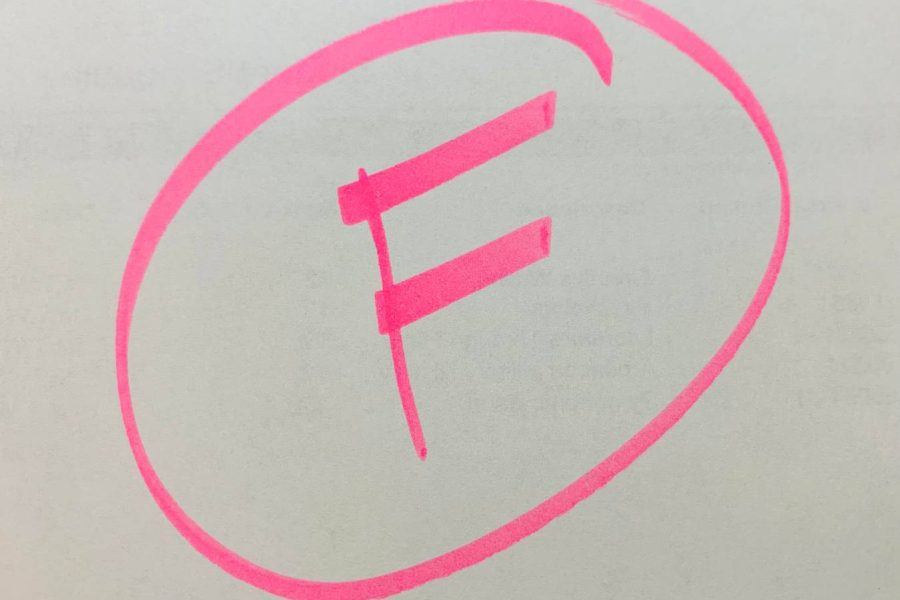Quarantining students need more support
Credit: Owen Davis
An illustration of a failing grade.
November 19, 2021
Students are back in school, masked up and ready to learn. Now, in addition to their work, students face a daunting task: staying healthy.
Something that didn’t sound so challenging once is now a huge problem. Getting COVID will require students to miss a minimum of eight days of classes. With this new challenge burdening students, there isn’t enough support being given.
COVID cases have been on the rise, in part because of the new Delta variant but also because of increased social interactions. At the start of September, there were just about forty million COVID cases in the U.S. Now, we have over forty-five million cases, as shown by the coronavirus tracker on KFF’s website, and it’s only been about a month and a half since school has begun. With this level of spread, some students are bound to get the virus while attending school in-person, and the schools aren’t doing enough to help.
“Waking up knowing that you couldn’t come back even though you did everything you could is somewhat depressing,” said senior Matthew Gray. Gray missed five days of school while waiting for a negative COVID test after he was in close contact with a student who tested positive.
Gray stayed up-to-date on his classes as much as he could, keeping in touch with his teachers and using tools available to him like Google Classroom.
“There was definitely a feeling of jet lag in my classes when I came back,” Gray said. “I felt behind emotionally.”
While he wasn’t behind on his work and assignments, Gray felt like he was missing pieces of his education from being out of the classroom. Gray wasn’t the only student to feel this way, many others echoed his thoughts.
“The most difficult part was definitely falling so far behind in my classes since I was unable to be in the classroom learning,” said senior Samantha Hogan, who missed a full two weeks after contracting COVID. “In order to keep up with all of my work, I would’ve been teaching myself physics or Supreme Court cases. It didn’t feel very hard during the actual quarantine period, but the last few weeks after coming back have not been easy.”
Hogan has felt large amounts of stress trying to get back into her classes after quarantining for so long and has felt that support has been mediocre.
“Support from my teachers was really a hit or a miss,” said Hogan. “Half of them were super helpful and did their best to make sure I felt supported and acknowledged. The other half didn’t quite do the same, and I was expected to keep up with my work like everyone else from my bedroom with Covid.”
Hogan later said that she has appreciated the support she has been given because it has allowed her to stay up-to-date in those classes and has helped her mental health in this tough time since she has been so worried and frustrated being out of class.
“I have never felt more behind in school. Losing two weeks of class time is not something I would wish for anybody because at times it feels as if there is no recovering from that,” Hogan said.
Students that are quarantined present a difficult challenge to instructors since many of our teachers have never had quarantined students in the past.
“A lot of the problem is that this is so new that I don’t have things prepared to give to students that can’t be in the classroom,” said Latin and math teacher Dyami Hernandez.
It can be hard getting all the information being taught when you miss classes since many lessons just aren’t the same when you’re not able to be a part of the discussion. Hernandez struggles to keep his students up-to-date in his classes since they are interactive lessons.
“A lot that I do in class is me, as a teacher, facilitating the information or interacting with the class,” Hernandez commented.
Hernandez feels that he doesn’t have a lot of options to help his missing students. He uses Google Classroom as much as he can to post materials and lesson items for his students to review when gone from the classroom. He also mentioned that since this is so new, teachers haven’t received any training, procedures, or even advice from the school on how to handle these situations.
I don’t think enough is being done by the school. We held an entire virtual year of school last year and yet students are still struggling and falling behind in their classes when they can’t be physically in the classroom due to circumstances that often aren’t their fault at all.
It is still relatively early in the year, and there is time for improvement. Unfortunately, we will all be stuck with this pandemic through the rest of this year. It’s unavoidable. However, even if the year is young, we cannot wait to make headway on a problem like this.
“If you think about the way trimesters work. If you think about my next trimester geometry class, I can look at what I’ve done this trimester and figure out what I can do for those absent kids,” said Hernandez.
Teachers and students will learn as we go and hopefully new ideas and resources come to light, like finding a system where we can record or stream the lectures and interactive lessons to the students sitting in their beds at home. Maybe access to online lessons that students can follow, complete with videos and coverage of topics students are missing such as websites like Khan Academy have, free to use and effortless for the teacher to assign.
Both of those options would be quick and simple for teachers, but more complicated solutions could be very hard for the teachers to implement when they’re already so busy.
A separate online curriculum that students could access when gone would be an amazing resource, but when will our teachers put that curriculum together? They’re already busy enough running their normal classes. What’s needed is a concentrated effort from the school district to help students and teachers find solutions to this problem since we can’t expect the teachers to do it all themselves.
Students need an effective solution, and reasonably quickly before lower grades and burnout become commonplace in our school.











